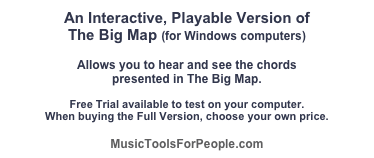Copyright 1998 - 2017 Stephen Mugglin
Permission is given to make not-for-profit copies of this material.
Copyright 1998 - 2017 Stephen Mugglin
Permission is given to make not-for-profit copies of this material.
Chord Charts and Maps
These charts and maps are designed to print on one page.
In the “Chord Picture” diagrams, the notes shown are played by the right hand. The bass note, played by the left hand, is not shown. Usually the bass note is the same letter name as the chord. For example, any chord with the name C (Cm6, CM7...) would have a C as its bass note.
Scales
Scale Diagrams for Twelve Major Keys
Chord Pictures
Chords With The Name C
More Chords With The Name C
Chords With The Name Db
More Chords With The Name Db
Chords With The Name D
More Chords With The Name D
Chords With The Name Eb
More Chords With The Name Eb
Chords With The Name E
More Chords With The Name E
Chords With The Name F
More Chords With The Name F
Chords With The Name Gb
More Chords With The Name Gb
Chords With The Name G
More Chords With The Name G
Chords With The Name Ab
More Chords With The Name Ab
Chords With The Name A
More Chords With The Name A
Chords With The Name Bb
More Chords With The Name Bb
Chords With The Name B
More Chords With The Name B
Chord Progression Maps
The Big Map In C
The Big Map In Db
The Big Map In D
The Big Map In Eb
The Big Map In E
The Big Map In F
The Big Map In Gb
The Big Map In G
The Big Map In Ab
The Big Map In A
The Big Map In Bb
The Big Map In B
The Generic Map
A Progression Map for Major Keys
"G" at Harp On encouraged me to create a generic map
with roman numerals instead of specific chords.
How Were the Maps Developed?
While studying music theory in college, I was introduced to ideas pertaining to chords and chord flow. After leaving college, I was teaching piano to young students for a while. Searching for ways to make chord flow accessible to young minds, I began drawing diagrams that would allow a child to create strong progressions. It seemed best to put each chord at a visual location with arrows to direct the flow. I experimented with different variations before choosing what I now call the Simple Map. Years later, I added the secondary chords that make the Big Map look the way it does.
I hope these pages, charts, and maps will help you understand chords and how they flow together. Enjoy writing music. Love and peace to all.
Ready for the Next Lesson?
This way to Part Six.






Read offline on your computer or tablet.


Other Resources








Our Other Apps
(Play Christmas Carols and Hymns)
(Play Basic Drum Patterns)
(Play Power Chords by Aiming
the iPhone in Different Directions)



